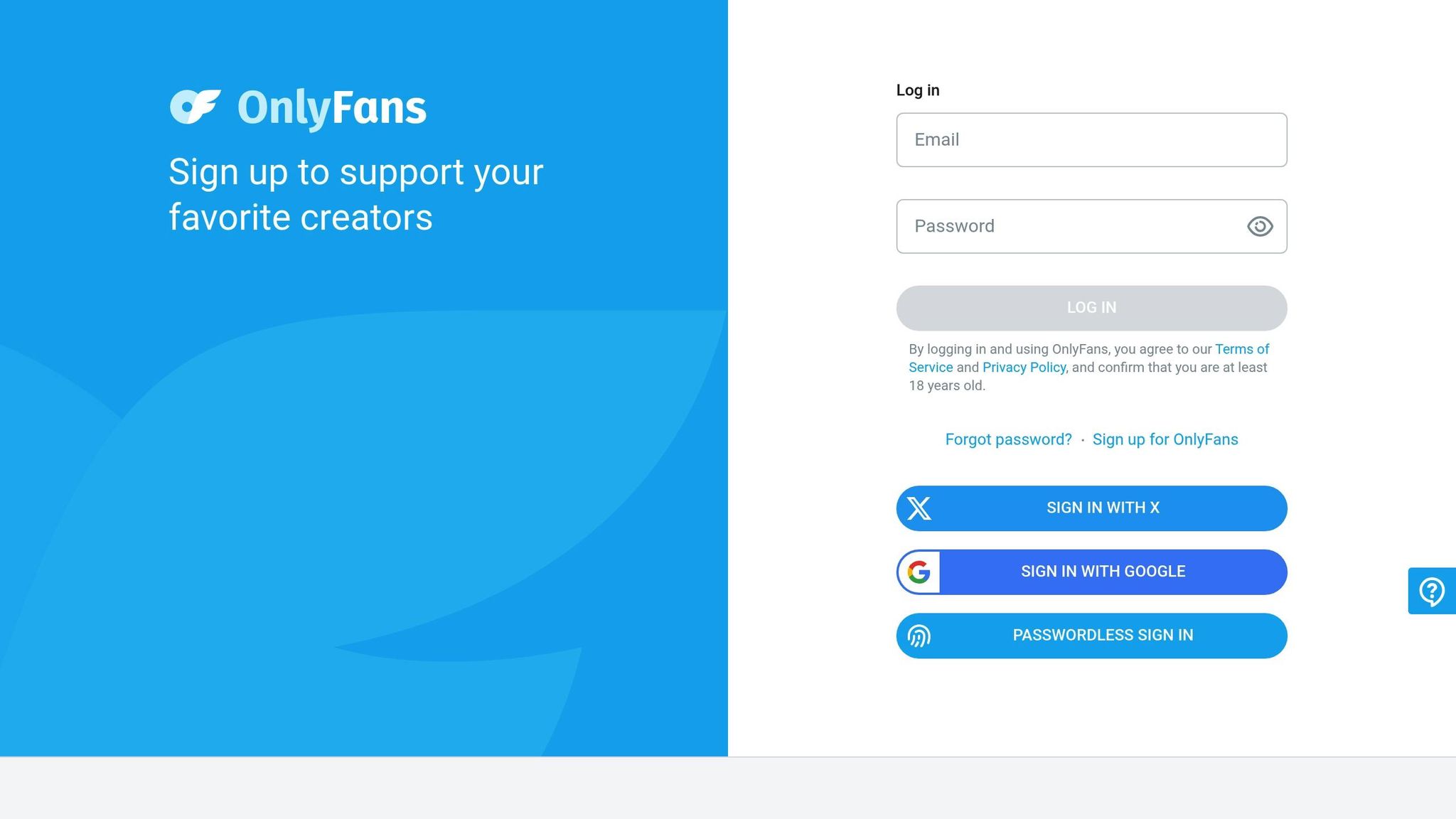Running an OnlyFans management agency can be a lucrative business if done right. Agencies typically earn through commissions (20%-50% of creators’ income), service fees (like photography and marketing), and onboarding fees ($500-$2,000). Profitability hinges on scaling revenue, minimizing costs, and focusing on top-performing creators who often generate 80% of earnings.
Key takeaways:
- Revenue Streams: Commissions, service fees, and onboarding fees.
- Cost Control: Use automation tools to cut labor costs and streamline operations.
- Focus: Prioritize high-earning creators for maximum returns.
- Challenges: Cash flow issues, creator acquisition costs, and market volatility.
Investing in tools like analytics platforms and creator discovery software can improve efficiency and profitability over time. Starting small and scaling with proven systems is the best approach for new agencies.
OnlyFans Management: Earning $250,000 profit per month on OnlyFans (Mistakes, Lessons, Advice)

1. How Agencies Make Money
OnlyFans management agencies rely on several revenue streams to generate income. Understanding these models is key to optimizing their earning potential.
Commission-based earnings are the primary source of revenue for most agencies. Typically, agencies take a cut ranging from 20% to 50% of a creator’s gross income. Interestingly, as a creator’s earnings increase, the commission rate often decreases, fostering a mutually beneficial growth model. This ensures that the agency’s success is closely tied to the creator’s progress.
Service-based fees add an extra layer of income beyond standard management. Agencies often charge for specialized services like professional photography, custom content creation, social media marketing, or negotiating brand partnerships. These services often come at a premium due to the expertise required and the measurable value they deliver. Such diversified offerings pave the way for scalable business models, which we’ll explore further.
Setup and onboarding fees provide upfront revenue when a creator signs on with an agency. These one-time charges, typically between $500 and $2,000, cover tasks like profile optimization, content strategy planning, account setup, and initial training sessions.
Scalability
Efficiently scaling revenue is vital for staying competitive and improving profit margins. The scalability of an agency’s income depends largely on its business model. Commission-based revenue naturally grows as creators earn more, but it also ties the agency’s earnings to creator performance. Agencies that focus on high-earning creators often see rapid revenue growth, as a small group of top performers can account for the bulk of their income.
Technology integration plays a key role in scaling operations. Tools like NimbusReach help agencies identify creators with strong fan engagement, maximizing commissions while minimizing effort. This targeted approach allows agencies to grow their revenue without significantly increasing operational costs.
Team structure is another factor in scalability. Agencies with standardized workflows for creator management can handle a larger number of clients without proportionally increasing expenses, which boosts profitability.
Cost Efficiency
Keeping costs under control is essential for turning revenue into profit. Creator acquisition costs can vary widely depending on the approach. Agencies that rely on referrals or data-driven prospecting generally spend less than those using broad advertising campaigns.
Service delivery costs also impact profitability. Commission-based income tends to have lower direct costs since it revolves around ongoing management rather than one-off services. However, services like photography or custom content creation involve specific resources and time, which must be accounted for in pricing.
Technology costs can help streamline operations and improve cost efficiency. Automation tools that handle tasks like scheduling, analytics, and outreach reduce labor expenses, making each dollar of revenue more profitable.
Profitability Impact
Combining scalable revenue streams with cost efficiency is the key to driving sustainable profits. High-margin services like strategy consulting or securing brand partnerships often yield better profits than basic account management, even if they generate less overall revenue.
Creator tier management also plays a crucial role. Agencies should prioritize their top-performing creators, as roughly 20% of creators often generate 80% of the revenue. Focusing on these high earners ensures that commission-based income continues to grow over time.
Recurring revenue stability from commission-based models provides a reliable cash flow, which supports long-term business growth. Unlike project-based fees that require constant new client acquisition, commissions grow alongside the success of existing clients, creating a more sustainable foundation for profitability.
The most successful agencies balance multiple revenue streams while concentrating on their highest-performing creators. This diversified approach ensures both steady income and growth opportunities, maximizing the return on their operational efforts.
2. Business Operating Expenses
Running an OnlyFans management agency comes with several key costs – staffing, technology, marketing, and office expenses – that directly influence profit margins. These costs play a crucial role in shaping strategic decisions, which will be explored in later sections on tools and profitability.
Staff and contractor costs tend to be the biggest expense. Account managers and communication specialists are typically paid at market rates, while roles like content strategists or social media managers, which require more expertise, command higher salaries. Many agencies also hire freelance chatters, whose hourly rates depend on their language skills and experience.
Technology and software expenses are essential for smooth operations. Tools like scheduling software, analytics platforms, and communication systems often come with fixed monthly subscription fees, especially for small to medium-sized agencies. On top of that, content creation and storage tools add to the overall cost.
Marketing and acquisition costs can vary significantly depending on the approach. Agencies relying on organic methods, like referrals and networking, may only need to spend on basic marketing tools or occasional event participation. On the other hand, those investing in paid ads or attending industry events will see higher marketing expenses.
Office and operational expenses include costs for workspace, utilities, insurance, and legal services. Many agencies start with remote operations to keep these costs low. However, more established agencies with physical offices may face higher expenses tied to their location.
Cost Efficiency
Managing expenses effectively often comes down to using automation tools. These tools handle repetitive tasks like scheduling posts, sending messages, and tracking performance metrics. While they require an upfront investment, they often pay for themselves quickly by reducing labor costs.
Outsourcing and automation also help cut down on staffing costs, allowing agencies to focus their efforts on revenue-generating activities. This strategy ties in with earlier discussions on scaling revenue, as it reduces variable costs while maintaining efficiency.
Optimizing your tech stack is another way to save. Choosing tools that work together seamlessly avoids redundant spending. For instance, platforms like NimbusReach streamline creator discovery and improve client acquisition, reducing costs while boosting quality.
Scalability
One advantage of fixed expenses is that they often stay consistent as revenue grows, improving profit margins. Costs like office rent, software subscriptions, and salaries for core management staff don’t increase proportionally with the client base, which enhances the cost-to-revenue ratio.
Standardized workflows also play a big role in scalability. By creating repeatable processes for tasks like onboarding, content planning, and performance tracking, agencies can manage a larger roster of creators without a significant rise in expenses.
Profitability Impact
Balancing expenses with revenue is critical for profitability. Agencies with higher fixed costs might face challenges early on, but as they scale, their profit margins can improve significantly. In contrast, agencies with mostly variable costs may enjoy steady margins but with less dramatic growth in profits.
Focusing resources on top-performing creators can further optimize profitability. A large portion of revenue often comes from a small group of high earners, so investing in their success yields better returns than spreading resources evenly across all clients.
Geography also plays a role in cost management. Agencies in high-cost areas may face steeper expenses for staffing and office space, while remote-first agencies can tap into global talent pools to keep costs down.
sbb-itb-bd3d2dc
3. Tools That Boost Profit Margins
Using the right tools can transform how agencies operate, helping them streamline processes, improve efficiency, and ultimately increase revenue for creators. Let’s dive into some specific tools that can make a measurable difference in both savings and income generation.
Automation platforms take over repetitive tasks, saving time and resources. For instance, customer relationship management (CRM) systems like HubSpot or Salesforce help agencies keep track of creator interactions and automate follow-ups. Similarly, social media scheduling tools such as Hootsuite or Buffer allow teams to manage content schedules across multiple platforms with ease, ensuring consistency and freeing up time for more strategic tasks.
Analytics and performance tracking tools provide valuable insights into creator performance. These tools can flag early signs of declining engagement, giving agencies the chance to tweak strategies before revenue takes a hit. Performance dashboards also help reallocate resources more effectively, ensuring efforts are focused where they’ll have the most impact.
Creator discovery platforms simplify the process of finding high-quality creators. Traditional cold outreach often has low success rates, but platforms like NimbusReach offer advanced search and filtering options, along with metrics like the Fan Devotion Score. This helps agencies identify creators with loyal, paying audiences, making new signings more profitable from the start.
Cost Efficiency
Beyond boosting output, these tools can significantly reduce operational costs. For example, chatbot systems can handle routine inquiries from creators, such as questions about payments or content guidelines. This allows staff to focus on tasks that directly drive revenue. Similarly, automated response systems can handle common queries, cutting down on labor-intensive communication.
Content management systems (CMS) are another cost-saving solution. Instead of creating unique posting schedules or content plans for every client, agencies can use templates and batch processing to streamline repetitive tasks. This reduces administrative overhead without compromising quality.
Financial tracking software like QuickBooks or FreshBooks also plays a big role in cutting costs. These tools automate tasks like invoicing and payment processing while providing real-time insights into profit margins. This makes it easier for agencies to identify which services or creator tiers are delivering the best returns.
Scalability
As agencies grow, the ability to scale efficiently becomes critical. Choosing tools that adapt to expanding operations can save time and money in the long run. Cloud-based communication systems like Slack or Microsoft Teams make it easy to onboard new team members and manage larger creator rosters. These platforms often integrate with other business tools, ensuring workflows remain smooth as the business scales.
When the number of creators grows significantly, professional database management systems become indispensable. While spreadsheets can quickly become unwieldy, dedicated database solutions allow agencies to track performance metrics, contract details, and payment schedules more efficiently.
Creator discovery platforms like NimbusReach are also built to scale. Features like the Fan Devotion Score maintain data accuracy and quality, even as search volumes increase. This ensures agencies can continue signing top-performing creators, focusing on those with the most engaged audiences – a strategy that often results in higher earnings from a smaller, high-performing group.
Profitability Impact
The right tools don’t just cut costs – they also drive revenue growth. For example, A/B testing platforms can help optimize content by identifying the best posting times, formats, and engagement strategies. This data-driven approach can significantly boost creator earnings.
Analytics tools are another game-changer. By analyzing subscriber behavior, agencies can make informed decisions about pricing, scheduling, and engagement strategies. These insights help maximize the lifetime value of each subscriber, directly impacting profitability.
Integration platforms like Zapier bring it all together by connecting different software systems. Automating data flows between analytics and financial tools allows agencies to quickly spot trends and adjust strategies in real-time.
Ultimately, the key to maximizing the return on investment (ROI) from tools lies in balancing cost reduction with improved service quality. Tools that only focus on cutting costs without enhancing the creator experience can lead to higher churn rates, which may negate any savings. The most effective tools are those that address key cost centers while also driving revenue growth, ensuring long-term profitability.
Pros and Cons
OnlyFans management agencies come with their own set of benefits and challenges. Understanding these dynamics is key to ensuring consistent growth and profitability in this competitive space.
One major advantage is revenue diversification. Unlike businesses that rely on a single income source, these agencies can tap into multiple streams: management fees, marketing services, content creation support, and even performance bonuses. This variety helps create financial stability, even when individual creators face fluctuations in their earnings.
However, such diversification also brings challenges. Tracking multiple revenue streams, managing varied commission structures, and keeping up with payment schedules can get complicated. Agencies often face cash flow issues when creator earnings dip – whether due to seasonal trends or changes in platform algorithms. These financial complexities also tie into scalability, a critical aspect of long-term success.
Scalability, when done right, is a huge plus. With efficient systems and processes in place, adding new creators doesn’t necessarily mean a proportional increase in operational costs. This can improve profit margins as the agency grows.
That said, client acquisition costs can be a significant barrier. Attracting high-quality creators who generate substantial revenue often requires a hefty upfront investment. For newer agencies, this can put a strain on their budgets.
To offset some of these challenges, many agencies turn to automation tools. Platforms like NimbusReach help identify creators while reducing manual labor costs. Additionally, tools like CRM systems and automated scheduling software can cut down on administrative overhead.
But there’s a flip side to this reliance on technology. Subscriptions, integration fees, and ongoing training can add up quickly. These costs often need to be absorbed long before any clear financial benefits are realized.
Here’s a quick breakdown of these trade-offs:
| Factor | Scalability | Cost Efficiency | Impact on Profits |
|---|---|---|---|
| Revenue Diversification | High – Multiple income streams grow together | Medium – Needs strong tracking systems | High – Adds stability and reduces risk |
| Creator Acquisition | Medium – Focus on quality over quantity | Low – High initial investment | High – Quality creators drive revenue |
| Automation Tools | High – Scales with increased volume | High – Cuts manual labor costs | Medium – Long-term benefits with upfront costs |
| Performance Analytics | High – Data-driven decisions scale well | Medium – Balancing costs vs insights | High – Optimizes creator earnings |
| Team Management | Low – Dependent on hiring/training | Low – Costs rise with growth | Medium – Good teams improve outcomes |
Performance analytics also play a key role in boosting creator earnings, which directly impacts agency commissions. But there’s a catch – many agencies collect tons of data without the expertise to turn it into actionable strategies. In such cases, data can become more of a distraction than a driver of growth.
Team scaling poses its own hurdles. To keep costs balanced and revenue flowing, hiring skilled professionals who understand the creator economy is crucial. However, experienced staff often come with high salary demands. Retaining top talent is equally challenging, as many professionals eventually leave to start their own ventures or collaborate directly with high-earning creators. High turnover disrupts client relationships and increases the cost of onboarding and training new hires.
Lastly, market volatility is a constant concern. Policy changes, economic downturns, or shifts in consumer spending can all impact creator earnings. While diversifying across platforms and creator tiers can reduce risk, it’s impossible to eliminate uncertainty entirely.
Conclusion
Running a profitable OnlyFans management agency requires a sharp focus on strategy and efficient operations. The most successful agencies recognize that the bulk of their income will come from a small number of standout creators, not from managing a large roster of mid-tier performers. This approach emphasizes quality over quantity when bringing on clients and naturally supports a more diverse revenue model – key for long-term growth.
Diversifying revenue streams – through management fees, marketing services, content support, and performance bonuses – creates stability. However, this also requires careful tracking of complex commission structures to ensure profitability.
The 80/20 rule is a game-changer in this business: about 20% of creators will generate 80% of your revenue. Investing in tools like NimbusReach can help identify creators with high engagement, ensuring your efforts are focused where they’ll yield the greatest returns.
While the upfront costs of automation and technology might seem steep, they’re worth it. These investments reduce manual work and make scaling easier by streamlining creator management and identifying potential high-earners.
Maintaining strong cash flow is essential. Agencies should aim to have reserves covering at least three months of operating expenses to weather seasonal trends or algorithm changes that might impact revenue.
The most profitable agencies succeed by building scalable systems. This involves creating standardized onboarding processes, replicable marketing strategies, and hiring team members who truly understand the creator economy. While experienced staff might demand higher salaries, their ability to boost creator earnings directly translates into higher commissions for the agency. These systems not only drive growth but also provide financial stability.
For new agencies, starting small is smart. A $25/month Starter plan for creator discovery is a practical first step. Once you’ve proven your ability to convert prospects into clients, upgrading your tools and systems becomes a logical move. Thoughtful investments in technology and processes will set the stage for long-term success and profitability.
FAQs
What are the best ways to attract top-tier creators to an OnlyFans management agency?
To bring in talented creators, focus on building authentic connections and offering services tailored to their unique needs. Start by reaching out through professional networks, social media, and industry-specific forums. Creators with engaged audiences in the range of 50,000 to 100,000 followers often make great partners – they’re typically on the rise and open to collaboration.
Showcase what sets your agency apart. Share success stories, highlight your expertise in helping creators expand their brands, and offer personalized support. Maintaining a professional yet approachable tone in your communication can go a long way in earning their trust and sparking their interest.
How can agencies ensure the cost of automation tools is worth the efficiency and profitability gains?
To ensure automation tools deliver value, agencies should prioritize return on investment (ROI). These tools can streamline workflows, cut down on manual tasks, and enhance both client acquisition and retention – all of which contribute to higher profitability. However, starting small with scalable solutions that fit your current budget is key. As your business grows, you can expand these tools accordingly.
Keep a close eye on performance metrics to confirm the tools are providing measurable benefits. If something isn’t working, tweak your strategies to avoid unnecessary spending and maintain efficiency. By aligning automation expenses with your agency’s growth, you can find the right balance between cost and profit.
What are the biggest cash flow challenges for OnlyFans management agencies, and how can they address them?
OnlyFans management agencies often grapple with cash flow issues stemming from uneven subscriber growth, limited traffic to creators’ pages, and intense competition. These factors can make income streams unpredictable and create financial instability.
To tackle these challenges, agencies can expand their marketing efforts by tapping into various traffic sources and running scalable campaigns, particularly on social media. Prioritizing strong client relationships and producing engaging, high-quality content can help boost subscriber retention, leading to a steadier income. On top of that, adopting tools like efficient client management systems can streamline operations, cut costs, and enhance overall profitability.





